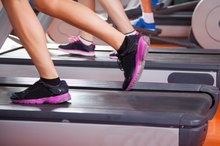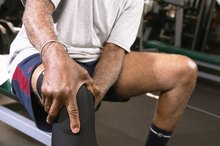Cycling & Patellar Tendonitis
Cycling provides a low-impact -- or non-weight-bearing -- exercise. Still, it's possible for a cyclist to suffer from a weight-bearing type of injury. It's just caused by a different mechanism of injury. Tendonitis can occur at any tendon site in your body -- areas that anchor muscle to bones. When these connective tissues become irritated and inflamed, it's described as tendonitis. Cyclists are prone to knee issues, especially patellar tendonitis.
Patellar Tendonitis
The patellar tendon connects the kneecap, or patella, to the shinbone. The tendon assists the muscles in extending the leg, aiding in crucial movements such as pedaling a bike, kicking an object and jumping. This is why it's commonly referred to as jumper's knee. Though there's no jumping involved in cycling, the tendon can become irritated or inflamed if your bike's saddle is too low or if you pedal a gear that causes high resistance. Both of these activities can strain your tendon, causing pain between your kneecap and where it attaches to your shin bone, or tibia.
- The patellar tendon connects the kneecap, or patella, to the shinbone.
- The tendon assists the muscles in extending the leg, aiding in crucial movements such as pedaling a bike, kicking an object and jumping.
Treatment
Knee Pain From Kicking a Ball
Learn More
If you experience patellar tendonitis, address the problem right away to avoid further complications or a lengthy recovery time. Stop doing any activity that causes the pain and apply ice several times a day to reduce inflammation. Elevate your leg, apply compression and take an anti-inflammatory medication 2. An infrapatellar strap can help reduce pain by supporting the tendon. If the pain becomes worse or interferes with your daily activities or if there is an increase in redness or swelling, call your doctor.
- If you experience patellar tendonitis, address the problem right away to avoid further complications or a lengthy recovery time.
Bike Fixes
One of the most common causes of patellar tendonitis is a bike saddle that's too low. When you first experience symptoms or after a few days of rest, try raising your saddle gradually, a few millimeters at a time. Your saddle might also be too far back. If you're unsure of how your bike should be set up, see a professional bike fitter who will assess your biomechanics and set up your bike properly. Most bike shops either have a professional fitter or can direct you to one. A fit will also help you avoid future injuries and increase the comfort of your ride.
- One of the most common causes of patellar tendonitis is a bike saddle that's too low.
- When you first experience symptoms or after a few days of rest, try raising your saddle gradually, a few millimeters at a time.
Considerations
Rehabilitation Exercises for Vastus Lateralis
Learn More
Ankling, which causes the foot to move from side to side during the pedal stroke, can place pressure on the patella. Have a bike fitter check your pedal and cleat system and assess how much float you have. If one of your legs is functionally longer than the other, this can cause the shorter leg to overextend, causing pain in your patella. A muscle imbalance or tight leg muscles can also cause the tendonitis. If the condition doesn't improve, see a physical therapist or orthopedist to address the cause and prescribe treatment.
- Ankling, which causes the foot to move from side to side during the pedal stroke, can place pressure on the patella.
Related Articles
References
- Dynamic Chiropractic: The Bicyclist, Part II; Thomas Souza
- University of Maryland Medical Center: Anterior Knee Pain
- Reinking MF. Current concepts in the treatment of patellar tendinopathy. Int J Sports Phys Ther. 2016;11(6):854–866.
- Cleveland Clinic. Patellar tendonitis.
- Brockmeyer M, Haupert A, Kohn D, Lorbach O. Surgical technique: jumper's knee-arthroscopic treatment of chronic tendinosis of the patellar tendon. Arthrosc Tech. 2016;5(6):e1419-e1424. doi:10.1016/j.eats.2016.08.010
- Michener LA, Kulig K. Not all tendons are created equal: implications for differing treatment approaches. J Orthop Sports Phys Ther. 2015;45(11):829-832. doi:10.2519/jospt.2015.0114
- Unlu MC, Kivrak A, Kayaalp ME, Birsel O, Akgun I. Peritendinous injection of platelet-rich plasma to treat tendinopathy: A retrospective review. Acta Orthop Traumatol Turc. 2017;51(6):482–487. doi:10.1016/j.aott.2017.10.003
Writer Bio
A professional writer since 2004, Abby Roberts holds a Bachelor of Arts in writing and has worked as a magazine editor, a staff writer and as a freelance writer for "Muscle and Fitness Hers" magazine. Roberts also produces a blog for female cyclists. She has experience working with cyclists in different facets of training and performance enhancement.









